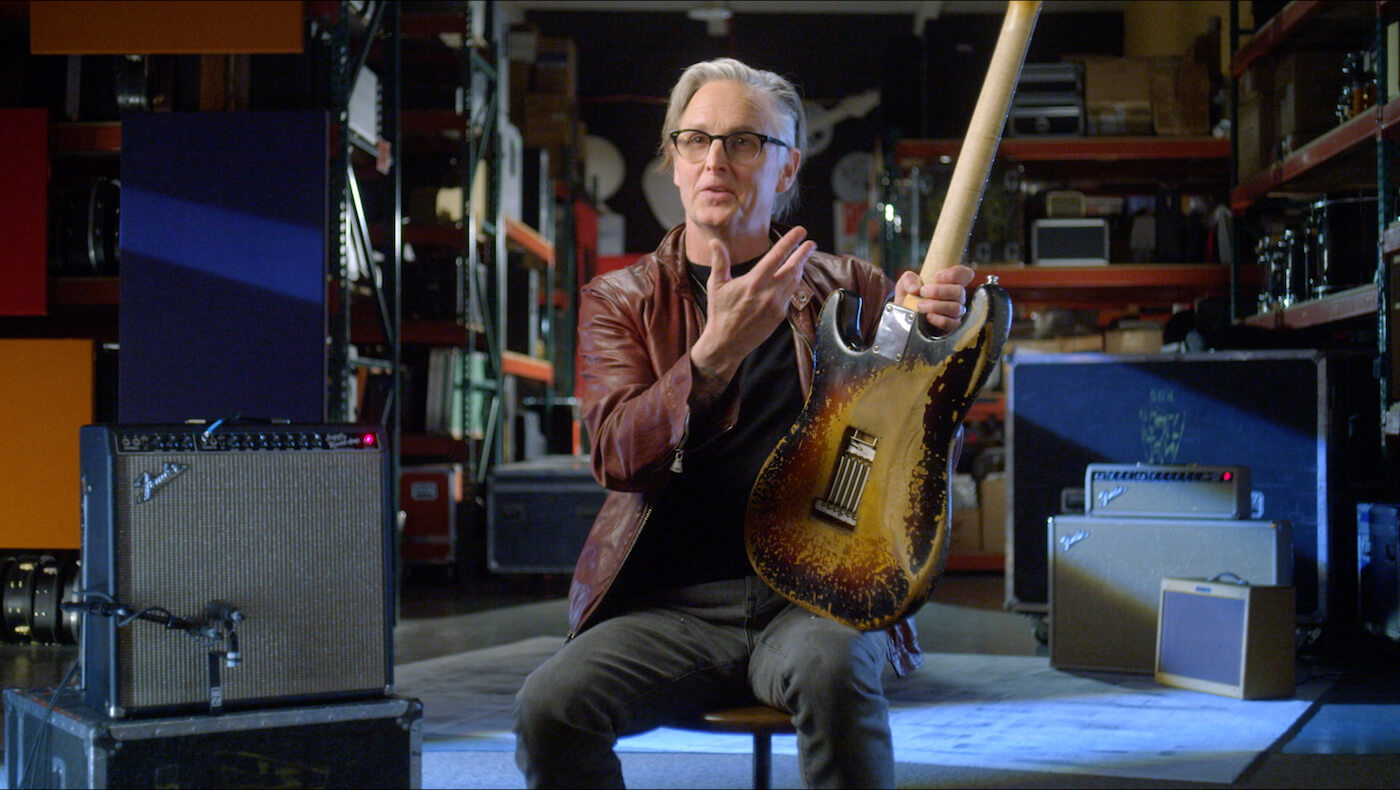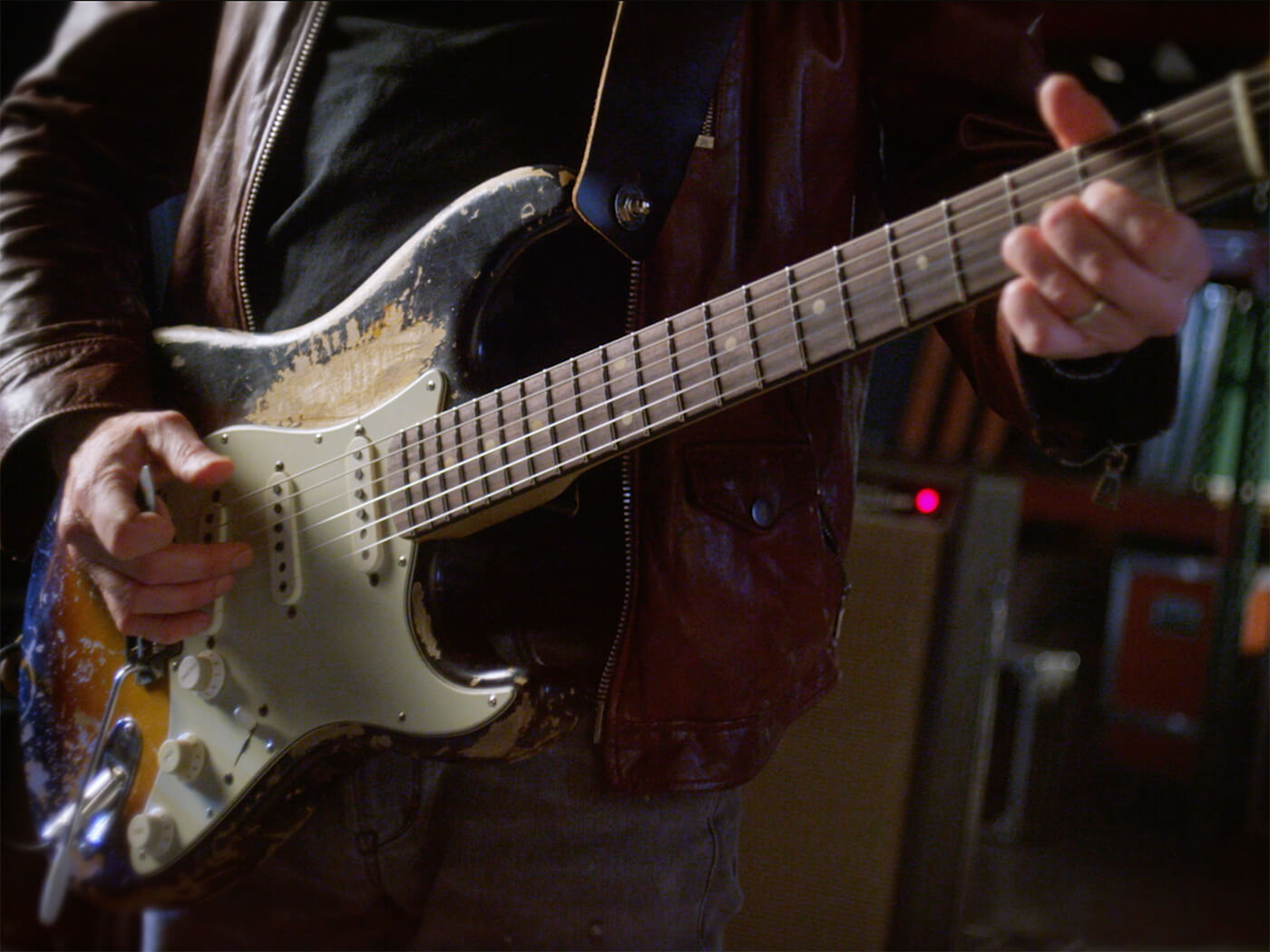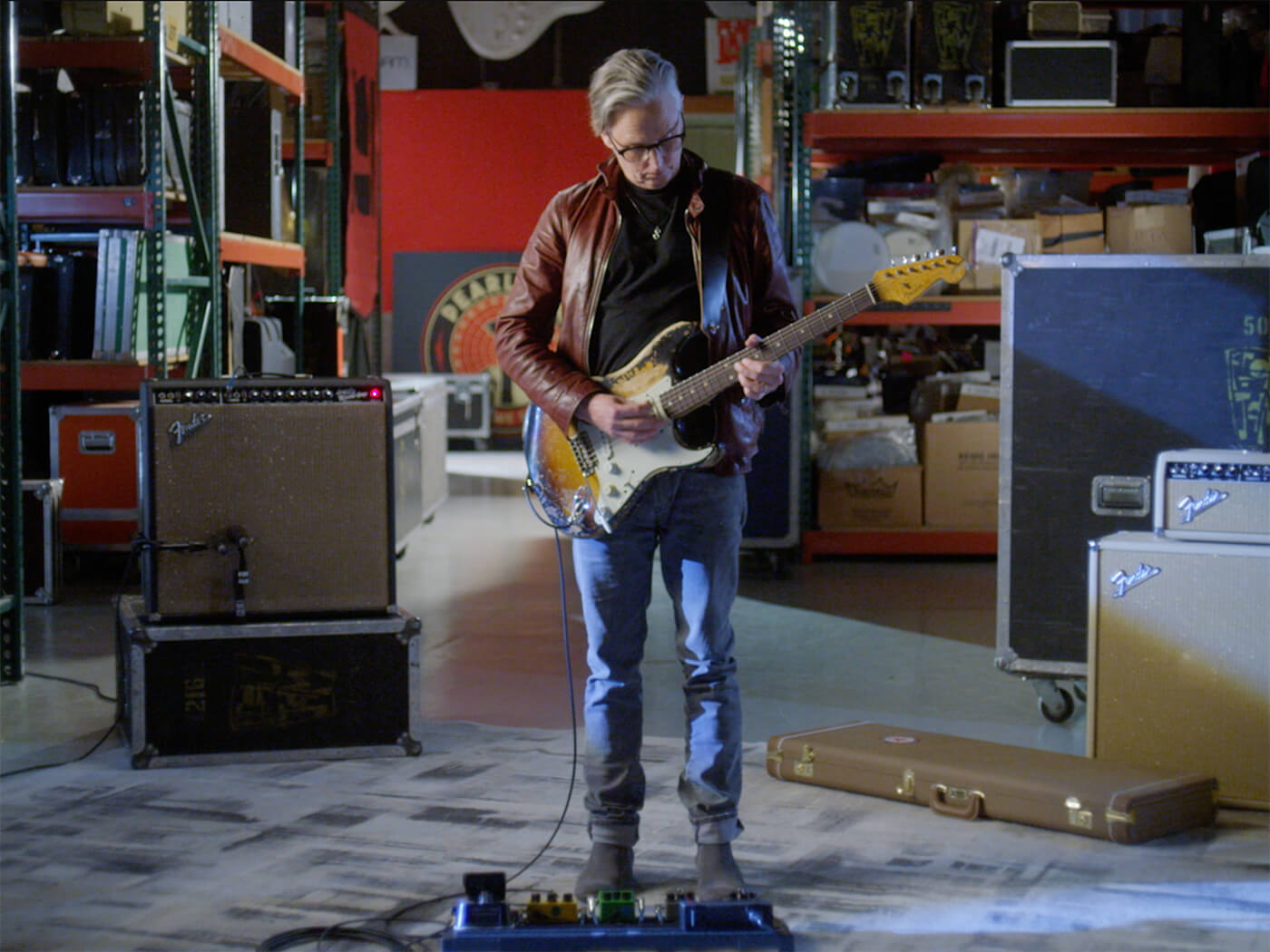“The secret is in the years of playing Even Flow on it 700 times”: Pearl Jam’s Mike McCready on capturing the magic of his new Custom Shop Strat
As the grunge icon gets his own Master Built signature model based on his 1960 Fender Stratocaster, he tells us about his love affair with the guitar and the shock of finding out it wasn’t a ’59.

Mike McCready of Pearl Jam. Image: Tim Durkan
When Pearl Jam’s debut album Ten started to make serious waves in the white heat of the Seattle grunge explosion of 1991, lead guitarist Mike McCready had one thing in mind as the cheques started to land on his doormat. “I had read Stevie Ray Vaughan used a ’59 Stratocaster, and I had seen him four times live and he blew my mind,” he tells us. “So that was the initial impetus behind my purchase: Stevie uses this guitar, this is the first time I have any money, I’m going to buy this guitar.”
McCready found what he believed to be an original ’59 Strat in Los Angeles, and he has become synonymous with the guitar over a now 30-year career with the Seattle giants and an array of side projects. The guitar has been recreated in painstaking detail by Fender Custom Shop Master Builder Vincent Van Trigt for a limited run of 200 instruments, and in the process was discovered to actually be a 1960 model. McCready is sanguine about the revelation.
“You know, I was so convinced it was ’59 that I got a tattoo of the number 59 on my arm,” laughs McCready. “George [Wood], who runs the Pearl Jam warehouse, kind of wanted to keep that it was a ’60 from me because I was always talking about how much I love my ’59 – my ’59 this and my ’59 that – and he didn’t want to break my heart and say, ‘Hey, you know, you bought a ’60…’ And so I’m still kind of shocked and blown away that it turned out to be a ’60, but ultimately it doesn’t matter because I love that guitar so much and it plays so amazingly well.”
And besides, SRV’s ’59 actually turned out to be a 60s hybrid with 1959 pickups, so McCready has perhaps being paying closer homage to his hero all these years than he realised at the time of purchase.
What is really important to McCready about the guitar – both his original and the new signature model – is how it plays and how it sounds, and the guitarist is delighted on both counts.
“Fender has done an incredible job,” he confirms, “And the greatest example I can give is that they’ll both be sitting next to each other, my real one, and the new model, and I have picked up the new model three times – on separate occasions – thinking it was the original. I’m not kidding, I would just start playing and only then realise, ‘Okay, this isn’t my guitar’. So it looks exactly like my guitar, it sounds almost exactly like it, but for me the most important thing is that the neck plays like it.”

Soul searching
That neck is a flat-sawn flame maple affair with a 1960 ‘oval C’ profile and a flat-lam rosewood fingerboard with 21 vintage frets and a bone nut. The back is heavily worn and wears a degree of crazing to the maple that adds to the sense of ’59-ness. It is here that McCready thinks the magic lies.
“I don’t exactly know how to say this, but I put a lot of value in the soul of a guitar,” he expands, “into how long a guitar has been played by somebody else, and how worn in it is with years of sweat and playing, and how set the neck is in its way.
“Even in terms of getting a new guitar, the neck has to play perfectly for me the first time I get it. If not, I can never adjust to how it is. I hope that makes sense, because I have a few guitars that are like that, that I’ve just never really gotten there with. They’re cool, but they never played as well as I like.
“But my original ’59… sorry, ’60, this guitar played fantastic as soon as I picked it up in 1992, and it has continued over the years. So the secret is in the years of sweating and playing Even Flow on it 700 times or whatever we’ve done. I’ve just worn it into a place where I really love it, but I’ve been able to do that because I already loved it beforehand.”
Another aspect of the guitar that was important to McCready was the tremolo. On the Custom Shop model Fender has used a vintage-style synchronized model with Callaham bridge block, married with vintage-style tuning machines. Stability is key for McCready here, and he is happy with the results.
“I usually have five springs on the back of my guitar, on the tailpiece,” he explains, “so it’s a tighter tremolo, not as loose. I need that for Jeremy, and I’ll use it again on Even Flow in the chorus.
“I’ll use the tremolo as a rhythmic tool, so two things: it has to stay in tune after I do all that – and that’s a hard thing to make happen on guitars – but my real one, for the most part, it stays in tune pretty great. And that’s something I really need when I’m using a tremolo because although I don’t use it all the time, when I do it’s for specific things in leads and specific parts of songs that require it.
“I can’t think beyond Jeremy off the top of my head, because I really go for it at the end of that song when I’m getting feedback. So the other thing is it’s got to be pretty strong, in terms of the strings behind it. But even then I still break them all the time!”
The Strat sound has been integral to his playing since he first hooked up with fellow guitarist Stone Gossard and bassist Jeff Ament in the aftermath of the collapse of their previous band, Mother Love Bone, in 1990 following the death of vocalist Andrew Wood. The trio’s first recorded output would be in tribute to Wood, hooking up with the singer’s flatmate and Soundgarden frontman Chris Cornell, plus that band’s drummer Matt Cameron (now a permanent fixture with Pearl Jam), in Temple Of The Dog.
The versatility of the Strat was something McCready was able to put to immediate use, although he wasn’t playing his 1960 back then.
“I love having five different positions on a Strat, as opposed to just three, and I use them all at different times,” explains McCready. “I’m going way back here but I use the ‘out of phase’ second position – I think it’s been explained that that’s the wrong term but I use it – on the beginning of Hunger Strike from that Temple record.
“And when I play Yellow Ledbetter live [a staple Pearl Jam set closer that is always played on the 1960 Strat], I will use that same position to play the verses of the song and the intro of the song, because it gets such a Little Wing sound that I always wanted to get. Stevie Ray Vaughan did that, so I was trying to do that, too.”
The Fender Limited Edition Mike McCready Stratocaster features custom Josefina hand-wound pickups, matched to the originals, that are connected to a five-way switch using vintage wiring, including a ‘treble bleed’ tone capacitor. McCready insists this is the essence of his guitar.
“When I’m doing leads, or whatever, I’m constantly going between pickups and it changes every time,” he tells us. “I can start off screaming on the high treble pickup, and then I can flip it all the way to the bass pickup, and then I’ll do a bluesy thing, and then I’ll go into the middle and then I’ll move it all over the place. Then I’ll get to those second and fourth positions. It’s like my brain needs that variety too.”
Magic Mike
From those earliest records to last year’s Pearl Jam release Gigaton, the Strat (and, since 1992, usually his 1960 model) has continued to play a regular part in the magic McCready brings to his lead playing both within his main band and without. In fact, it is often the guitar McCready turns to when Pearl Jam’s music heads for less predictable waters.
Gigaton was perhaps the band’s most diverse and experimental album since 2000’s Binaural, and both of those albums feature favourite McCready Strat moments. The former’s lead single, Dance Of The Clairvoyants, was a Talking Heads-inspired nod to the 1980s that McCready instantly turned to his Strat for.
“That was one of our strangest songs that I feel we’ve ever recorded,” recalls Mike. “I remember that Matt brought in this drum loop and I thought it was cool, but I just never thought anybody was going to go for it, I didn’t think Ed would maybe sing over it, I didn’t known what was going to go on with that thing. But Stone ended up putting this rhythm track to it and then it started making sense. And I wanted to approach it kind of in a Carlos Alomar ‘David Bowie-era’ guitar playing way: that staccato funk with a tight reverb on it. That’s what I was going for and I knew I could get that sound with this guitar. I just know I can innately trust this guitar to make that happen.
“In terms of Nothing As It Seems [from Binaural], same thing. Nothing As It Seems is maybe one of my favourite sounding solos because I used this weird, huge pedal that was made by Gretsch for about one year and it was the strangest thing. I forget its name but it has, like, a vocoder sound on it and it was made in the late sixties or early seventies [likely the Expandafuzz – Ed]. I think it almost put Gretsch out of business. Anyway, I use that, and Tchad Blake, who was our producer at the time, got this sound. I’ve never been able to get it except for on that record, but that’s my Fender Strat through that weird Gretsch pedal. That’s how we got that weird buzz sound that you hear on Nothing As It Seems, which I love.”

Recalling his time with Mad Season – a short-lived Seattle supergroup featuring Mike on guitar and Alice In Chains’ Layne Staley on vocals that released one album, the devastating Above in 1994 – McCready tells us again that he knew when he needed his ’60 Strat: “When I wrote River Of Deceit for the Mad Season record, I was thinking in terms of that ‘out of phase’ sound I talked about earlier. I use it for the intro and actually the whole song, except for in the chorus where I turn it on to the treble pickup, so I knew I needed this guitar for River Of Deceit. I knew I wanted that sound for the riff, and I know this guitar will give it to me.
“I also used it on that record on November Hotel – which was my dad’s call number when he was an F4 Phantom pilot in the Vietnam War – because I know I can control the kind of feedback that I get with this Strat, and the bar on it.”
Battle scars
Talk of Mad Season and November Hotel’s squalling feedback leads us down memory lane to a gig at Seattle’s Moore Theatre by the band in 1995. During a stunning and extended rendition of that very song McCready repeatedly drives the headstock of his original ’60 into a Marshall speaker cab. Examining all the wear and damage so lovingly recreated by Van Trigt on the Master Built Signature Model, our eyes are drawn to a large and conspicuously repaired chip in the headstock…
“You know, I think it might have happened at that show,” says McCready. “I need to be honest with you, I don’t remember exactly where that happened. I remember that it did happen, though, and I was really not that excited about it! I had been trying to do it methodically, you know, so I would just hit the speaker and it looks cool and it makes weird sounds, but I don’t break the neck, because I used to do that all the time with my other Fenders and break so many of them.
“But with this one, I was trying to be careful, and in my craziness to get into what we were doing, whether it was a Pearl Jam show or that Mad Season show, or a Neil Young show that we played because I thought for a long time it was this Neil Young show that we did when I was trying to get some crazy sounds at the end of Down By The River, but I just went for it and I hit the wood of the speaker cabinet and that knocked the cap off the top of that guitar. And I don’t know to this day where that chip went, but I immediately said to myself, oh, don’t ever do that again to your guitar. But I love that Vincent at Fender has re-created that ominous chip exactly like it was. And even down to how the sticker came off up there.”

The authenticity of the cosmetic damage on this signature model is something that will no doubt appeal to Pearl Jam fans and collectors, but in examining the wear and tear on the rest of the guitar McCready warns that while it is currently an exact replica of his original, it may not stay that way for long!
“A lot of the scratches on the back are not mine,” Mike insists, “they were already there. But if you look at the top of the guitar, where I’m picking above the scratchplate, those scratches are mine. And if you look at photos from 1992 up until now you’ll see how this scratched area has gotten bigger and bigger and bigger from years of just strumming on it really hard. If you look at the guitar when I first started playing it, the cuts, you can barely see them.”
The pandemic has already seen Pearl Jam reschedule huge tours of the USA and Europe in support of Gigaton (twice now in the case of Europe), but the band is itching to be back on stage – “I can’t wait,” says McCready – and given the energy with which they famously play, Mike McCready’s original 1960 Fender Stratocaster is going to get a lot more scratched up in the hopefully not-too-distant future.
Find out more about the Fender Custom Shop Master Built Mike McCready 1960 Stratocaster at fender.com.

